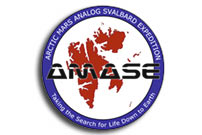NASA Arctic Mars Analog Svalbard Expedition Field Report (AMASE 2007): Beginning of the End

08.22.07
I wish today could last forever. The weather and landscape has been magical and I feel as if I never want to leave.
We’ve been sailing back from Wahlenberg Fjord since last night. Some time in the middle of the night, we stopped at a cabin and picked up a girl who is a student at UNIS. She has been camping with some friends for the last nine days and had arranged a ride back to Longyearbyen.
We drove into Raudfjord this afternoon for a sightseeing trip. There is a cabin on the eastern side, Raudfjordhytta, where Hans spent his first weeks in the field in Svalbard. This is one of the numerous “trapper cabins” scattered around Svalbard. The cabin consists of two tiny rooms made of very old, sun bleached wood. The roof is flat and covered in corrugated tin. It is not a shelter most people would find themselves looking to spend a winter in. Four workers from the Svalbard Governor flew in by helicopter to repair roof leaks while we were there. It is unclear when the cabin was built- there were a few diary entries scribbled on the wall from the 1930s, accompanied by a few pieces of paper with entries from more recent inhabitants. Scattered on the ground around the cabin were old remains from the days when the cabin was in use; a wooden dog sled, a rusty stove pipe; all looking a bit ancient.
We took a short hike up a hill behind the cabin. There are two graves from old sailors on the hill. Their coffins sit on the ground and are covered in cobbles as the permafrost prevents underground burial. Their life up here must have been very hard and little is known about them or the cause of their death, but their final resting place is among the most beautiful places on Svalbard.
The last Zodiac of people lingered on the shore. The fjord was bright and beautiful as it had been all day. The sky was blue, the wind was light, sharply cut mountain peaks circled the fjord, their surfaces glistening with recent snow. Standing on the shore, avoiding returning to the ship we were quiet and I was reminded of my final Zodiac ride in Murchison Fjord last year. Hans, Ivar and I had motored so slowly back to the Lance, not wanting to leave the magic of the far northern reaches.
Back on the Lance, many of us wandered the deck for the next few hours watching the spectacular series of mountains, glaciers, fjords and icebergs flow by. After dinner the Spanish Raman team’s request of yesterday came true. The captain was able to gently sidle our ship up alongside a relatively large iceberg. Slowly, the Raman laser gear was hauled up from below deck and they fired their bright green laser at different points on the iceberg, capturing its spectral signature.
In one way, it seems perfectly normal to want to measure the spectra of something as common as ice. Good plan for an instrument team hoping to find evidence of habitability on Mars, right? In another way, it was an obscenely hilarious sight to watch a large ship “cuddle with an iceberg” as Steve Squyres put it and shoot it with laser beams!! Lance kept adjusting slightly to keep the iceberg at the correct angle for the laser sitting on the deck and nearly everyone was on deck watching the sight. The green light bounced around the iceberg surface, some measurements on the ice, some in the adjacent water. When a bird landed nearby, we wondered what might happen if it crossed the path of the beam, but luckily that did not become an issue.
We are leaving northern Svalbard now, headed towards Ebbadalen, our first field site from last year. It is about an hour and a half sail up Isfjorden from Longyearbyen. I know there are four more days of AMASE 07, but I can’t help but feel that my favorite part of the trip is coming to a close.
Kirsten Fristad
NASA Goddard Space Flight Center
About Kirsten Fristad in her own words…
Kirsten Fristad here again. I’m privileged and excited to be back writing Notes from the Field on AMASE 07. I am a planetary scientist working in the Sample Analysis on Mars (SAM) Lab at the Goddard Space Flight Center in Greenbelt, Maryland where I have been for the last year and a half. I graduated from Macalester College in 2005 with a major in geology and core in astronomy knowing I wanted to pursue a research career in planetary science. Through summer internships with several planetary scientists, I developed a background in analyzing martian and lunar planetary remote sensing data and Mars analog field work in Alaska. Over the last year I have continued to organize the Goddard/SAM Team contribution to AMASE, conducted organic analyses of AMASE samples, designed and built new field hardware and participated in two other expeditions in Utah and the Mojave.
Following AMASE 07, I will be staying on in Norway as a Fulbright Scholar to begin graduate work at the University of Oslo. I am very much looking forward to exploring more of this beautiful country, reconnecting with the country of my ancestors and filling up on pickled herring and lefse!








